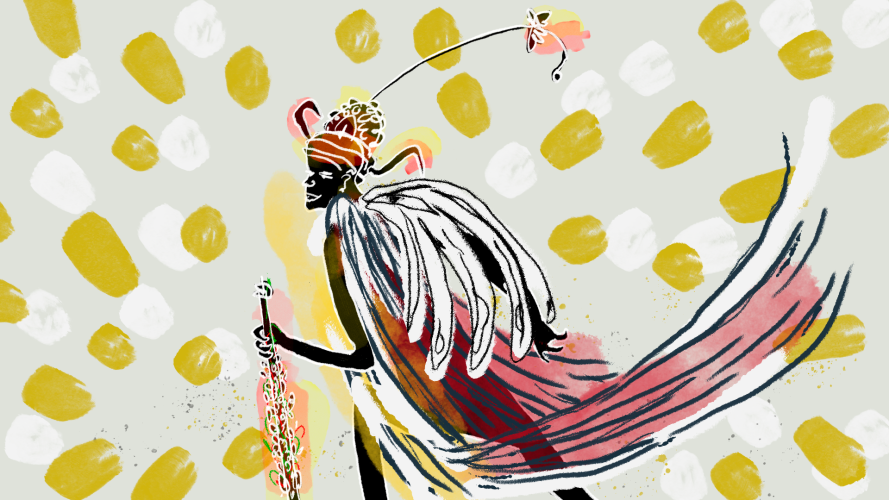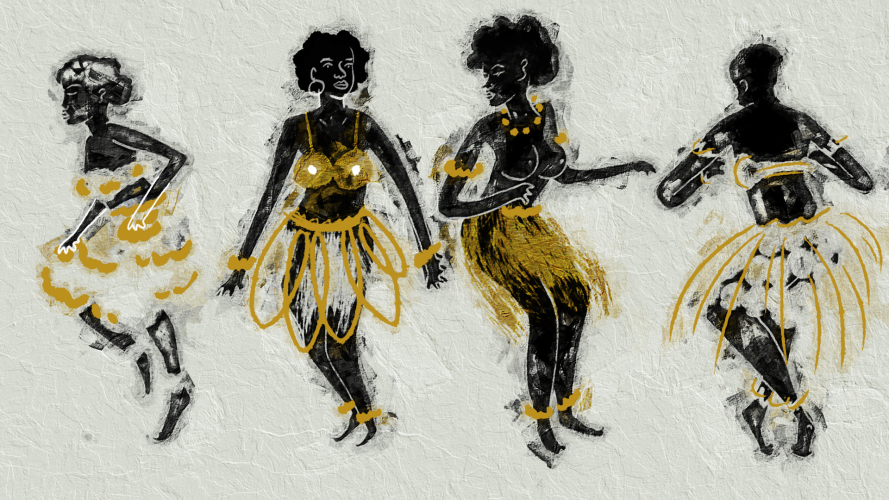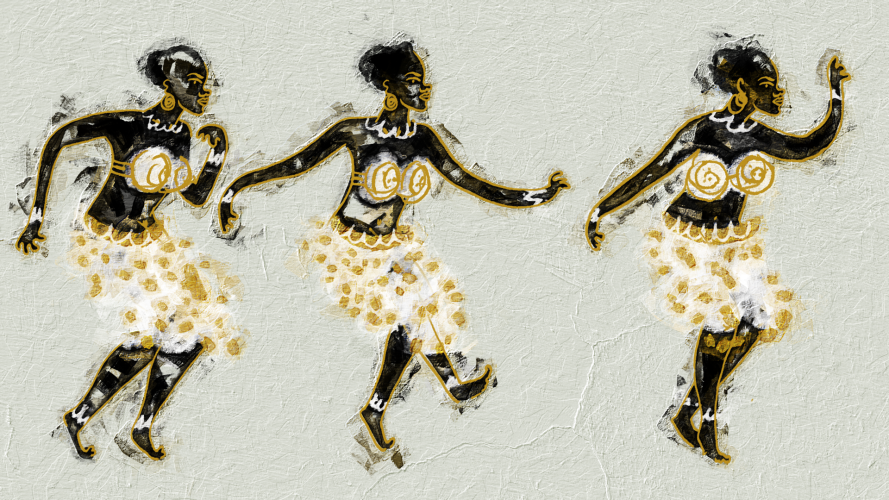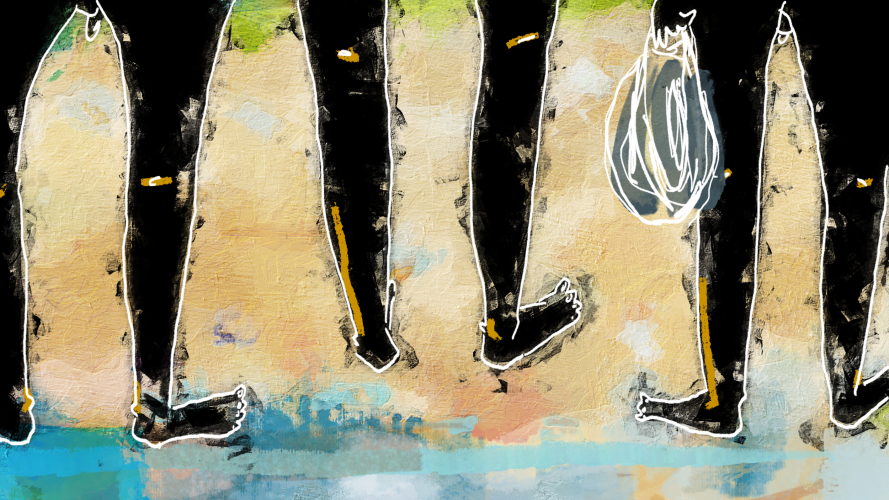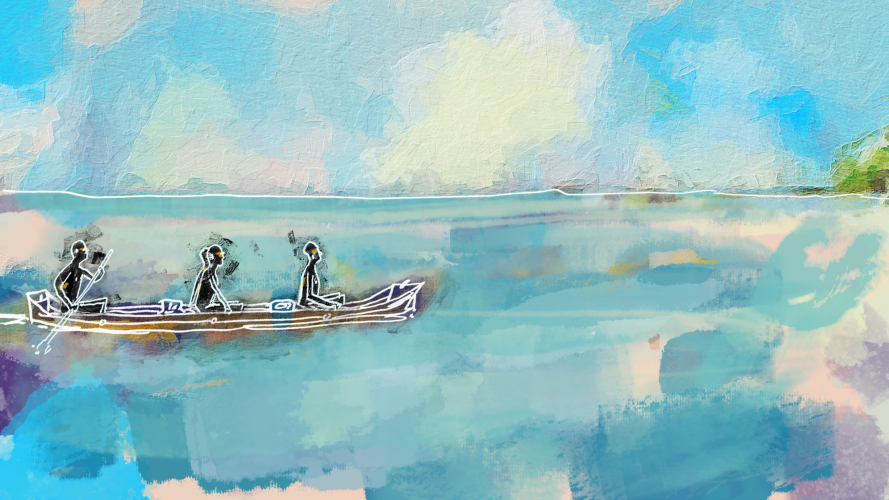30’ short animated documentary by Paulo Patrício
Documentário que revisita o período que vai de entre 1973 e 1976, imediatamente antes e a seguir à independência da Guiné-Bissau, em que as danças tradicionais de diferentes etnias foram cruciais na reafricanização, unificação e afirmação do povo guineense. Recorrendo a depoimentos sobre a importância social e militar da dança durante a luta de libertação, acompanhando ao mesmo tempo o percurso do Ballet Nacional – Esta É A Nossa Pátria Amada, que através da incorporação de danças étnicas nas suas peças, contribuiu significativamente para a unidade cultural do país. Peças essas que são aqui parcialmente recriadas para ilustrar este período de viragem na história e identidade da Guiné-Bissau.
Documentary that revisits the period between 1973 and 1976, immediately before and after the independence of Guinea-Bissau, in which the traditional dances of different ethnicities were crucial in the re-Africanization, unification and affirmation of the Guinean people. Using testimonies about the social and military importance of dance during the liberation struggle, at the same time following the trajectory of the Ballet Nacional – Esta É A Nossa Pátria Amada, which, through the incorporation of ethnic dances in its performances, contributed significantly to the unity culture of the country. These performances are partially recreated here to illustrate this turning point in the history and identity of Guinea-Bissau.
Este documentário híbrido revisita o historial do Ballet Nacional da Guiné-Bissau, oficialmente conhecido como Ballet Nacional – Esta É A Nossa Pátria Amada, contando com o testemunho em imagem real de quem participou na sua fundação e desenvolvimento, assim como de um historiador, recriando em animação excertos de obras do seu repertório, cujos registos foram totalmente destruídos.
Fundado em 1975 e com cerca de quatro década de existência (é a instituição cultural mais antiga da Guiné-Bissau), o Ballet Nacional tem um vasto repertório de obras tradicionais e contemporâneas que combinam as mais variadas etnias culturais guineenses. Nele estão sintetizadas artisticamente a complexa evolução política da Guiné-Bissau, o que permitiu não só a reconstrução de uma identidade coletiva amplamente reconhecida dentro e fora do país, mas também serviu como espelho das esperanças e dificuldades de um povo à procura da sua própria identidade. Esse repertório traduz, portanto, tudo isso. E se é aí que está a sua maior riqueza, também é aí que reside o seu maior drama: devido à instabilidade político-militar e aos tumultuosos acontecimentos da história recente do país, todos os registos desse repertório foram totalmente destruídos.
Além de recriar e fixar excertos desse repertório, este documentário posiciona-se entre a vivência de Jackelina Ramos Camará, bailarina e fundadora do Ballet Nacional; e a perspectiva de Leonardo Cardoso, historiador e antigo presidente do Instituto Nacional de Cinema e Audiovisual da Guiné-Bissau. Uma dicotomia interessante: sendo natural da Guiné-Conacri, Jackelina apaixonou-se por um comandante do PAIGC (Partido Africano da Independência da Guiné e Cabo Verde) durante a luta de libertação, suscitando com isso conversações políticas ao mais alto nível entre Sékou-Touré e Amílcar Cabral; por sua vez Leonardo, como historiador e no cargo que assumiu, confrontou-se com a destruição de materiais que permitiriam reconstruir parte da cultura guineense, mais ainda, na adolescência acompanhou – nas zonas libertadas pelo PAIGC – a realidade do Ballet Nacional, o que faz dele uma testemunha crucial no trabalho de memória sobre a dança guineense.
Ambos simbolizam, grosso modo, a realidade do Ballet Nacional, que com altos e baixos continua activo, mas cujo repertório desapareceu da memória material. Tanto que alguns guarda-roupas foram sendo reusados em repetições de espetáculos, num processo atávico e fragilizado de sobrevivência. Como refere Francesca Cataldi (“Choreographies Of African Identities”, 2006), os ballets nacionais africanos nasceram das lutas de libertação e independência, redesenhando as histórias perdidas e recalcadas de séculos de existência, funcionando como uma forma de “escrita da nação”. A experiência coreográfica destes ballets, representam ainda a tentativa de misturar tradições étnicas, multiplicando os seus efeitos para além das comunidades de origem, promovendo e assinalando uma memória nacional e transnacional interétnica.
Considerados pelo poder colonial como povos “sem história”, a verdade é que estes países tiveram na dança uma oportunidade de reescrever a sua própria história. Daí que a destruição ou o desaparecimento dos vestígios materiais destas coreografias e das histórias de vida dos seus protagonistas ser, mais uma vez, uma desmemorialização da história, feita de ligações muitas vezes imprevistas e encadeadas ao longo de gerações. A recuperação destas ligações neste documentário, ajuda a contribuir para uma “história potencial”, como refere Ariella Azoulay (“Potential History”, 2019). Ou seja, a partir da memória perdida pode fazer-se uma “próxima história”. E nela, a dança, nas suas múltiplas dimensões, do quotidiano à política, é um horizonte de esperança, uma machadada no opressivo e no desigual.
Daí a recriação em animação, que é simbólica por natureza, de excertos das obras mais significativas, enquadrando-os no documentário – apoiado na investigação, consultoria científica e histórica dos investigadores Francisco Azevedo Mendes e Marie Manuela Silva – de forma a que pontilhem visualmente a história oral do Ballet Nacional. Criando assim, uma renovada e “próxima história”, desde logo pelas temáticas abordadas nas obras, a título de exemplo: “Okinka Pampa”, dedicada à resistência aos colonos no arquipélago dos Bijagós; “Império de Kansala”, sobre a história do império do Kaabu, sucessor do império do Mali no espaço da Guiné-Bissau; “Balobeiro”, à volta das adorações e crenças africanas; “Para Kéma Matu”, um apelo contra os fogos postos; “Velho N’bundé”, sobre a importância dos mais velhos na sociedade guineense; “Morte de Cabral”, abordagem ao assassinato de Amílcar Cabral; “3 de Agosto”, dedicada aos primeiros grupos de resistência guineense. Existindo muitas e muitas outras, que vão desde o paludismo ao HIV, todas elas refletindo de uma forma singular a estranha relação que há entre a arte, a memória, a realidade e o poder.
This hybrid documentary revisits the history of the National Ballet of Guinea-Bissau, officially known as Ballet Nacional – Esta É A Nossa Pátria Amada, with real-life testimony from those who participated in its founding and development, as well as a historian, recreating in animation excerpts of works from his repertoire, whose recordings were completely destroyed.
Founded in 1975 and with nearly four decades of existence (it is the oldest cultural institution in Guinea-Bissau), the National Ballet has a vast repertoire of traditional and contemporary works that combine the most varied Guinean cultural ethnic groups. In it are artistically synthesized the complex political evolution of Guinea-Bissau, which not only allowed the reconstruction of a collective identity widely recognized inside and outside the country, but also served as a mirror of the hopes and difficulties of a people in search of their own identity. . This repertoire translates, therefore, all of that. And if that’s where its greatest wealth lies, that’s also where its greatest drama lies: due to political-military instability and the tumultuous events in the country’s recent history, all records of that repertoire were totally destroyed.
In addition to recreating and recording excerpts from this repertoire, this documentary takes a stand between the experience of Jackelina Ramos Camará, dancer and founder of the National Ballet; and the perspective of Leonardo Cardoso, historian and former president of the National Institute of Cinema and Audiovisual of Guinea-Bissau. An interesting dichotomy: being a native of Guinea-Conakry, Jackelina fell in love with a commander of the PAIGC (African Independence Party of Guinea and Cape Verde) during the liberation struggle, thus giving rise to political talks at the highest level between Sékou-Touré and Amílcar Cabral; Leonardo, in turn, as a historian and in the position he assumed, was confronted with the destruction of materials that would allow him to rebuild part of Guinean culture, even more so, in his adolescence he followed – in the zones liberated by the PAIGC – the reality of the National Ballet, which makes him a crucial witness in the memory work on Guinean dance.
Both symbolize, roughly speaking, the reality of the National Ballet, which with ups and downs remains active, but whose repertoire has disappeared from material memory. So much so that some wardrobes were reused in repetitions of shows, in an atavistic and fragile process of survival. As Francesca Cataldi points out (“Choreographies Of African Identities”, 2006), African national ballets were born out of struggles for liberation and independence, redesigning the lost and repressed stories of centuries of existence, functioning as a form of “writing of the nation”. The choreographic experience of these ballets also represents an attempt to mix ethnic traditions, multiplying their effects beyond the communities of origin, promoting and marking an interethnic national and transnational memory.
Considered by the colonial power as people “without history”, the truth is that these countries had in dance an opportunity to rewrite their own history. Hence, the destruction or disappearance of the material traces of these choreographies and the life stories of their protagonists is, once again, a dememorialization of history, made up of often unforeseen connections and chained over generations. The recovery of these connections in this documentary helps to contribute to a “potential history”, as Ariella Azoulay refers (“Potential History”, 2019). That is, from the lost memory, a “next story” can be made. And in it, dance, in its multiple dimensions, from everyday life to politics, is a horizon of hope, an ax blow to the oppressive and unequal.
Hence the recreation in animation, which is symbolic by nature, of excerpts from the most significant works, framing them in the documentary – supported by research, scientific and historical consultancy by researchers Francisco Azevedo Mendes and Marie Manuela Silva – in such a way that they visually dot the oral history of the National Ballet. Thus creating a renewed and “next story”, firstly through the themes addressed in the works, for example: “Okinka Pampa”, dedicated to resistance to settlers in the Bijagós archipelago; “Kansala Empire”, about the history of the Kaabu empire, successor to the Mali empire in Guinea-Bissau; “Balobeiro”, around African worship and beliefs; “For Kéma Matu”, an appeal against arson; “Velho N’bundé”, about the importance of the elderly in Guinean society; “Death of Cabral”, approach to the murder of Amílcar Cabral; “3 de Agosto”, dedicated to the first Guinean resistance groups. There are many, many others, ranging from malaria to HIV, all of them reflecting in a unique way the strange relationship that exists between art, memory, reality and power.
Budget: 90.000,00 €
Secured financing: 20.000,00 € ( financial support by ICA)



